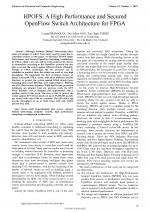| 3/2019 - 3 |
HPOFS: A High Performance and Secured OpenFlow Switch Architecture for FPGAPHAM-QUOC, C. |
| Extra paper information in |
| Click to see author's profile in |
| Download PDF |
Author keywords
field programmable gate arrays, software defined networking, computer security, high performance computing, reconfigurable architectures
References keywords
networks(12), link(12), software(10), defined(10), security(9), openflow(9), network(8), networking(7), communications(7), ddos(6)
Blue keywords are present in both the references section and the paper title.
About this article
Date of Publication: 2019-08-31
Volume 19, Issue 3, Year 2019, On page(s): 19 - 28
ISSN: 1582-7445, e-ISSN: 1844-7600
Digital Object Identifier: 10.4316/AECE.2019.03003
Web of Science Accession Number: 000486574100003
SCOPUS ID: 85072163116
Abstract
Although Software Defined Networking offers many advantages, it suffers from many security issues due to centralized control. In this paper, we introduce HPOFS (High-Performance and Secured OpenFlow Switching Architecture) for FPGA which is not only able to route packets from sources to destinations according to the OpenFlow protocol but also able to protect the system against different attacks efficiently. Thanks to FPGA technology, the two processes can be scheduled in parallel; thus, the switch can work at very high throughput. We implement the first prototype version on Xilinx xc5vtx240t FPGA device with three different security functions to protect the system against DDoS attack types, including Hop-count filtering, port Ingress/Egress filtering, and SYN Flood attacks defender. While the first two protection techniques are adapted from our previous work, the SYN Flood defender core is designed and implemented with a pipeline model in this work. The core is able to protect the system against SYN Flood attacks at up to 30,000,000 packets per second with only 0.248 ms overhead. The full switch can provide throughput at up to 78.96 Gbps with only 0.0012 percent drop rate. |
| References | | | Cited By |
Web of Science® Times Cited: 2 [View]
View record in Web of Science® [View]
View Related Records® [View]
Updated 3 weeks, 6 days ago
SCOPUS® Times Cited: 2
View record in SCOPUS® [Free preview]
View citations in SCOPUS® [Free preview]
[1] Heterogeneous Hardware-based Network Intrusion Detection System with Multiple Approaches for SDN, Ngo, Duc-Minh, Pham-Quoc, Cuong, Thinh, Tran Ngoc, Mobile Networks and Applications, ISSN 1383-469X, Issue 3, Volume 25, 2020.
Digital Object Identifier: 10.1007/s11036-019-01437-x [CrossRef]
[2] A comprehensive survey of DDoS defense solutions in SDN: Taxonomy, research challenges, and future directions, Kaur, Sukhveer, Kumar, Krishan, Aggarwal, Naveen, Singh, Gurdeep, Computers & Security, ISSN 0167-4048, Issue , 2021.
Digital Object Identifier: 10.1016/j.cose.2021.102423 [CrossRef]
Disclaimer: All information displayed above was retrieved by using remote connections to respective databases. For the best user experience, we update all data by using background processes, and use caches in order to reduce the load on the servers we retrieve the information from. As we have no control on the availability of the database servers and sometimes the Internet connectivity may be affected, we do not guarantee the information is correct or complete. For the most accurate data, please always consult the database sites directly. Some external links require authentication or an institutional subscription.
Web of Science® is a registered trademark of Clarivate Analytics, Scopus® is a registered trademark of Elsevier B.V., other product names, company names, brand names, trademarks and logos are the property of their respective owners.
Faculty of Electrical Engineering and Computer Science
Stefan cel Mare University of Suceava, Romania
All rights reserved: Advances in Electrical and Computer Engineering is a registered trademark of the Stefan cel Mare University of Suceava. No part of this publication may be reproduced, stored in a retrieval system, photocopied, recorded or archived, without the written permission from the Editor. When authors submit their papers for publication, they agree that the copyright for their article be transferred to the Faculty of Electrical Engineering and Computer Science, Stefan cel Mare University of Suceava, Romania, if and only if the articles are accepted for publication. The copyright covers the exclusive rights to reproduce and distribute the article, including reprints and translations.
Permission for other use: The copyright owner's consent does not extend to copying for general distribution, for promotion, for creating new works, or for resale. Specific written permission must be obtained from the Editor for such copying. Direct linking to files hosted on this website is strictly prohibited.
Disclaimer: Whilst every effort is made by the publishers and editorial board to see that no inaccurate or misleading data, opinions or statements appear in this journal, they wish to make it clear that all information and opinions formulated in the articles, as well as linguistic accuracy, are the sole responsibility of the author.



